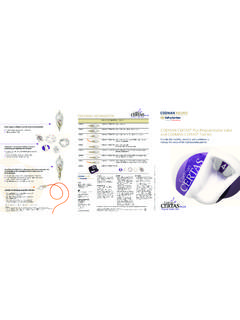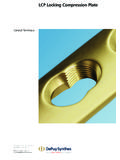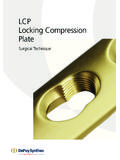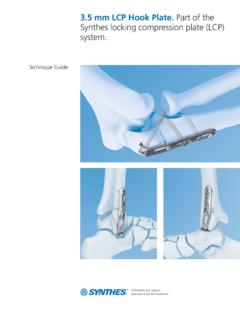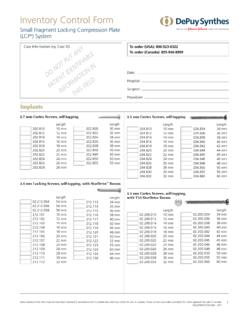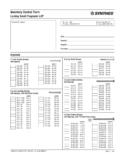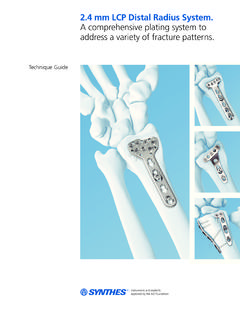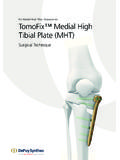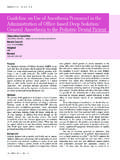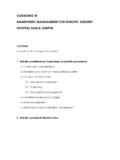Transcription of PFNA-II. Proximal Femoral Nail Antirotation.
1 PFNA-II. Proximal Femoral nail TechniqueThis publication is not intended for distribution in the and implants approved by the AO intensifier controlWarningThis description alone does not provide sufficient background for direct use of DePuy Synthes products. Instruction by a surgeon experienced in handling these products is highly , Reprocessing, Care and MaintenanceFor general guidelines, function control and dismantling of multi-part instruments, as well as processing guidelines for implants, please contact your local sales representative or refer to.
2 General information about reprocessing, care and maintenance of Synthes reusable devices, instrument trays and cases, as well as processing of Synthes non-sterile implants, please consult the Important Information leaflet (SE_023827) or refer to: Surgical Technique DePuy Synthes 1 Table of ContentsIntroductionSurgical Technique Product Information Bibliography
3 83 MRI Information 84 Introduction 2AO Principles 5 Indications and Contraindications 6 Clinical Cases 7 Preoperative Planning 8 Patient Positioning 9 Preparation 10 Open Femur 14 Insert nail 19 Proximal Locking 22 Distal Locking 40 For PFNA-II Short 42 For PFNA-II Long 48 Insert End Cap 51 Implant Removal 53 Correction of Insertion Depth of PFNA-II Blade 56 Cleaning 57 Implants 58 Alternative Implants 64 Instruments 67 Cases 76 Power Tools 80 Optional: Angular Stable Locking System (ASLS) 812 DePuy Synthes PFNA-II Surgical TechniquePFNA-II.
4 Rapid, reliable and innovative. Developed for small statured NailExcellent fit The design is adapted to the anatomical situation in small statured patients. The lateral flattened cross-section ease distal locking optionsStatic or dynamic locking can be per-formed via the aiming arm with PFNA-II standard, small and xs. The PFNA-II long additionally allows for secondary PFNA-II has a medial-lateral angle of 5 This allows insertion at the tip of the greater stress distributionThe flexible PFNA-II tip eases insertion and reduces stress on the bone at the tip of the shortPFNA-II longStaticDynamicStaticDynamicStatic (90 )PFNA-II Surgical Technique DePuy Synthes 3 PFNA-II NailProduct rangeThe PFNA-II is available in 4 sizesPFNA-II long, length 260 340 mm (with 20 mm increments)
5 , length 340 420 mm (with 40 mm increments, only B 10 mm nails), bending radius 1500 mmPFNA-II, length 240 mmPFNA-II small, length 200 mmPFNA-II xs, length 170 mm4 DePuy Synthes PFNA-II Surgical TechniqueRotational and angular stability achieved with one single elementCompaction of cancellous boneInserting the PFNA-II blade compacts the cancellous bone providing additional anchoring, which is especially important in osteoporotic Proximal Femoral nail BladeBone structure after PFNA-II blade inser tion cancellous bone is compacted providing additional anchoring to the PFNA-II surface and increasing core diameter guarantee maximum compaction and optimal hold in boneIncreased stability caused by bone compaction around the PFNA-II blade has been biomechanically proven to retard rotation and varus collapse.
6 Biomechanical tests have demonstrated that the PFNA-II blade had a significantly higher cut-out resistance in comparison with commonly-used screw locking fast and reliable insertion of the PFNA-II blade All surgical steps required to insert the PFNA-II blade are performed through lateral incision The PFNA-II blade is automatically locked to prevent rotation of the blade and Femoral headPFNA-II blade unlockedPFNA-II blade lockedBone structure before insertion of the PFNA-II Surgical Technique DePuy Synthes 5AO PrinciplesIn 1958, the AO formulated four basic principles1, 2, which have become the guidelines for internal fixation in general, and intramedullary nailing in particular:Anatomic reductionBefore inserting the nail , the reduction can be achieved manually or using a reduction table.
7 A guide wire marks the prescribed path into the medullary canal and secures align-ment of the fragments while the cannulated nail is being inserted over the wire. The nail insertion is generally moni-tored using x-rays. The nail is then locked proximally and distally to the bone fragments in order to hold the fixationThe intramedullary nail acts as an internal splint that controls but does not prevent micromovements of the fragments. It provides a relative stability that leads to an indirect healing through callus formation.
8 The nails are available in different diameters that allow the surgeon to optimize stability. Preservation of blood supplyWhen the canal is not reamed, intramedullary nailing generates minimal trauma to the endosteum and, therefore, the blood supply is maximized through the uninjured endosteum and periosteum. Reaming the canal temporarily disrupts the endosteal blood supply but probably stimulates the revascularisation and therefore the bone , active mobilizationIntramedullary nailing, combined with the AO technique, provides relatively stable fracture fixation with minimal trauma to vascular supply.
9 This helps to create an improved environment for bone healing, accelerating the patient s return to previous mobility and M ller ME, Allg wer M, Schneider R, Willenegger H (1995) Manual of Internal Fixation. 3rd, expanded and completely revised ed. 1991. Berlin, Heidelberg, New York: Springer2 R edi TP, Buckley RE, Moran CG (2007) AO Principles of Fracture Management. 2nd expanded ed. 2002. Stuttgart, New York: Thieme6 DePuy Synthes PFNA-II Surgical TechniquePFNA-II short (Length 170 mm 240 mm)Indications Pertrochanteric fractures (31-A1 and 31-A2) Intertrochanteric fractures (31-A3) High subtrochanteric fractures (32-A1) Contraindications Low subtrochanteric fractures Femoral shaft fractures Isolated or combined medial Femoral neck fracturesIndications and ContraindicationsPFNA-II long (Length 260 mm 420 mm)
10 Indications Low and extended subtrochanteric fractures Ipsilateral trochanteric fractures Combination fractures (in the Proximal femur) Pathological fractures Contraindications Isolated or combined medial Femoral neck fracturesNote: ASLS, the Angular Stable Locking System, is indicated in cases where increased stability is needed in fractures closer to the metaphyseal area or in poor quality bone. For more details regarding the intramedullary fixator principle, please consult the ASLS technique guide ( ) and concept flyer ( ).
